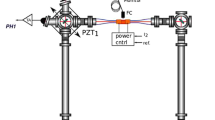Abstract
In recent years, the measurement of rotational components of earthquake-induced ground motion became a reality due to high-resolution ring laser gyroscopes. As a consequence of the fact that they exploit the Sagnac effect, these devices are entirely insensitive to translational motion and are able to measure the rotation rate with high linearity and accuracy over a wide frequency band. During the last decade, a substantial number of earthquakes were recorded by the large ring lasers located in Germany, New Zealand, and USA, and the subsequent data analysis demonstrated reliability and consistency of the results with respect to theoretical models. However, most of the observations recorded teleseismic events in the far-field. The substantial mass and the size of these active interferometers make their near-field application difficult. Therefore, the passive counterparts of ring lasers, the fiber optic gyros can be used for seismic applications where the mobility is more important than extreme precision. These sensors provide reasonable accuracy and are small in size, which makes them perfect candidates for strong motion applications. The other advantage of fiber optic gyroscopes is that if the earthquake is local and shallow (like one occurred early this year at Canterbury, New Zealand), the large ring lasers simply do not have the dynamic range—the effect is far too large for these instruments. In this paper, we analyze a typical commercially available tactical grade fiber optic gyroscope (VG-951) with respect to the seismic rotation measurement requirements. The initial test results including translation and upper bounds of seismic rotation sensitivity are presented. The advantages and limitations of tactical grade fiber optic gyroscope as seismic rotation sensor are discussed.














Similar content being viewed by others
References
Allan DW (1966) Statistics of atomic frequency standards. Proc IEEE 54:221–230
Aronowitz F (1999) Fundamentals of the ring laser gyro. In: Optical gyros and their application. RTO AGARDograph 339:3-1–3-45
Boore DM (2001) Effect of baseline corrections on displacements and response spectra for several recordings of the 1999 Chi-Chi, Taiwan, earthquake. Bull Seismol Soc Am 91(5):1199–1211
Cowsik R, Madziwa-Nussinov T, Wagoner K, Wiens D, Wysession M (2009) Performance characteristics of a rotational seismometer for near-field and engineering applications. Bull Seism Soc Am—Special Issue on Rotational Seismology 99(2B):1181–1189
Graizer V (2006) Equation of pendulum motion including rotations and its implications to the strong-ground motion. In: Teisseyre R, Majewski E, Takeo M (eds) Earthquake source asymmetry, structural media and rotation effects. Springer, Berlin, pp 471–485
Graizer V (2006b) Theoretical basis for rotational effects in strong motion and some results. In: Rotational workshop, 16.02.2006. Menlo Park/Pasadena, CA
Grazer V (2006) Tilts in strong ground motion. Bull Seismol Soc Am 96(6):2090–2102
Graizer V (2010) Strong motion recordings and residual displacements: what are we actually recording in strong motion seismology? Seismol Res Lett 81(4):635–639
IEEE (1998) IEEE standard specification format guide and test procedure for single-axis interferometric fiber optic gyros. Institute of Electrical and Electronics Engineers, New York
Igel H, Schreiber U, Flaws A, Schuberth B, Velikoseltsev A, Cochard A (2005) Rotational motions induced by the M8.1 Tokachi-Oki earthquake, September 25, 2003. GRL 32(8):L08,309.1–L08,309.5
Igel H, Cochard A, Wassermann J, Flaws A, Schreiber U, Velikoseltsev A, Dinh NP (2006) Broad-band observations of earthquake-induced rotational ground motions. Geophys J Int 168(4):182–196
Lawrence A (1998) Modern inertial technology: navigation, guidance, and control. Mechanical Engineering series, 2nd edn. Springer, New York
Lefevre H (1993) The fiber-optic gyroscope. Artec House, Boston
Lin C-J, Huang H-P, Liu C-C, Chiu H-C (2010) Application of rotational sensors to correcting rotation-induced effects on accelerometers. Bull Seismol Soc Am 100(2):585–597
Nigbor RL (1994) Six-degree-of-freedom ground-motion measurement. Bull Seismol Soc Am 84(5):1665–1669
Nigbor RL, Evans JR, Hutt CR (2009) Laboratory and field testing of commercial rotational seismometers. Bull Seism Soc Am—Special Issue on Rotational Seismology 99(2B):1215–1227
Pancha A, Webb TH, Stedman GE, McLeod DP, Schreiber U (2000) Ring laser detection of rotations from teleseismic waves. GRL 27:3553–3556 (2000)
Pillet R, Virieux J (2007) The effects of seismic rotations on inertial sensors. Geophys J Int 171(3):1314–1323
Sanders G, Szafraniec B (1999) Progress in fiber-optic gyroscope applications ii with emphasis on the theory of depolarized gyros. In: Loukianov DP, Rodloff R, Sorg H, Stieler B (eds) Optical gyros and their application, vol. 339. RTO AGARD, Neuilly sur Seine, pp 11.1–11.42
Schreiber KU, Stedman GE, Igel H, Flaws A (2006) Ring laser gyroscopes as rotation sensors for seismic wave studies. In: Teisseyre R, Majewski E, Takeo M (eds) Earthquake source asymmetry, structural media and rotation effects. Springer, Berlin, pp 377–390
Schreiber KU, Carr AJ, Franco-Anaya R, Velikoseltsev A (2009) The application of fiber optic gyroscopes for the measurement of rotations in structural engineering. Bull Seism Soc Am—Special Issue on Rotational Seismology 99(2B):1207–1214
Suryanto W, Igel H, Wassermann J, Cochard A, Schuberth B, Vollmer D, Scherbaum F, Schreiber U, Velikoseltsev A (2006) First comparison of array-derived rotational ground motions with direct ring laser measurements. BSSA 96(6):2059–2071
Takamori A, Araya A, Otake Y, Ishidoshiro K, Ando M (2009) Research and development status of a new rotational seismometer based on the flux pinning effect of a superconductor. Bull Seism Soc Am—Special Issue on Rotational Seismology 99(2B):1174–1180
Acknowledgements
This research was supported in part by grant from the Federal Targeted Programme “Scientific and scientific–pedagogical personnel of the innovative Russia in 2009–2013” of the Ministry of Education and Science of the Russian Federation. We acknowledge the support of Matthew Pannell, who implemented the FOG monitoring system in the Rutherford building.
Author information
Authors and Affiliations
Corresponding author
Rights and permissions
About this article
Cite this article
Velikoseltsev, A., Schreiber, K.U., Yankovsky, A. et al. On the application of fiber optic gyroscopes for detection of seismic rotations. J Seismol 16, 623–637 (2012). https://doi.org/10.1007/s10950-012-9282-y
Received:
Accepted:
Published:
Issue Date:
DOI: https://doi.org/10.1007/s10950-012-9282-y




